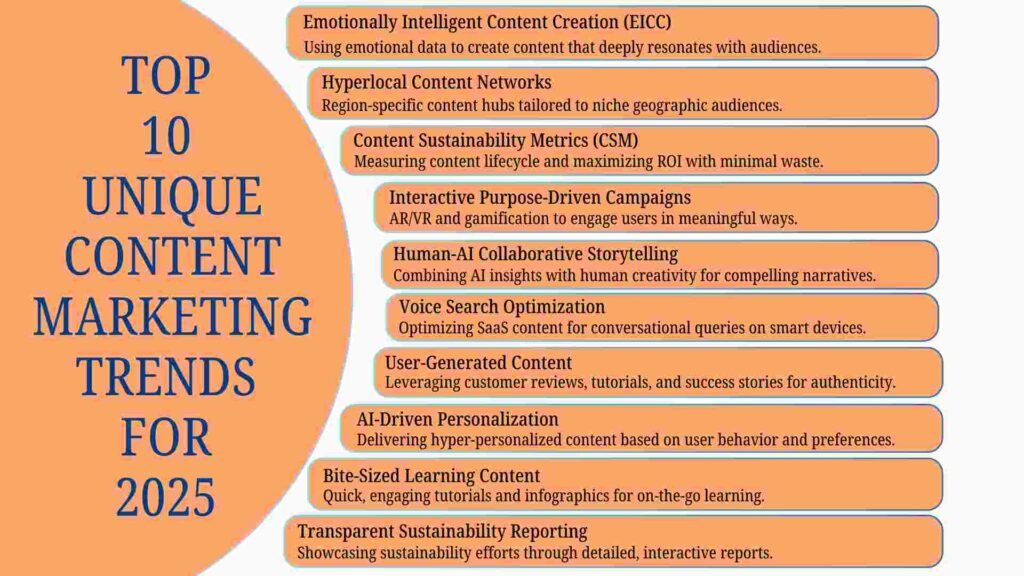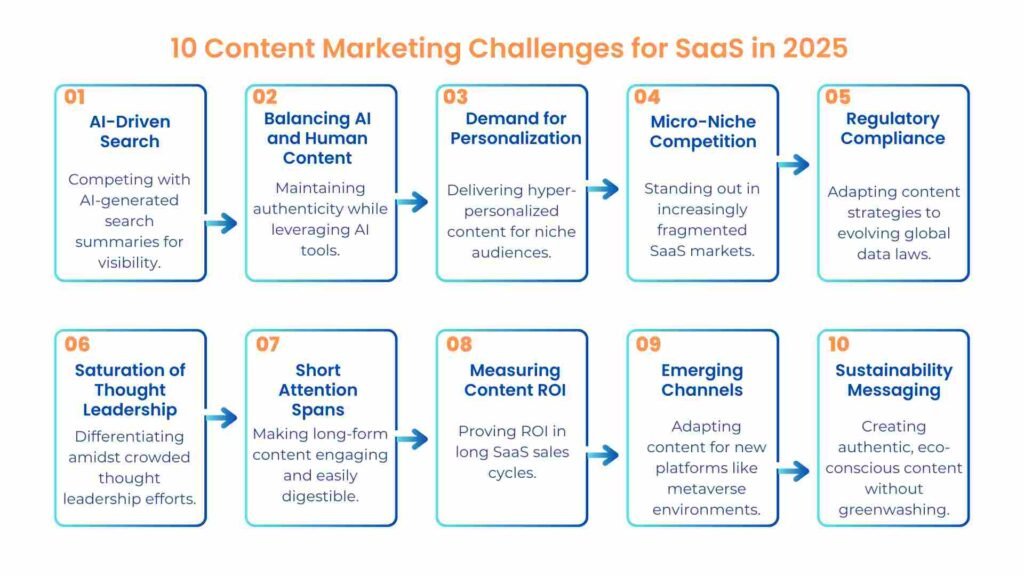Content Marketing in 2025: Trends That Demand Attention
Content marketing never stands still.
Strategies that once dominated may no longer deliver the same results, challenging businesses to rethink their approach to engagement and relevance.
For decision-makers in SaaS and IT industries, staying ahead means more than just adopting the latest tools.
It requires a nuanced understanding of your audience’s evolving preferences and adapting to their changing behaviors. Content marketing is no longer a static play—it’s an adaptive framework that must reflect the dynamic needs of your target market.
This guide delves into five pivotal trends poised to reshape content marketing in 2025.
These forward-thinking strategies are not mere extensions of existing practices; they represent a new way of connecting with audiences. Designed with decision-makers in mind, these trends will empower you to build sustainable, impactful campaigns that drive measurable results.

Emotionally Intelligent Content Creation (EICC)
Content marketing in 2025 takes a bold leap into Emotionally Intelligent Content Creation (EICC), reshaping how brands connect with their audience. This isn’t about superficial personalization like addressing users by name. This trend leverages emotional data analytics to create highly resonant content, elevating content marketing strategies beyond traditional personalization techniques.
How It Works: Advanced AI now deciphers emotional cues from user interactions in real time. Beyond analyzing behavior, these tools interpret tone and sentiment to refine content delivery. For instance, an AI-powered system could recommend distinctly different content to a frustrated user (detected through tone in a support query) versus an enthusiastic one.
Example in Practice: Consider an e-commerce SaaS platform that senses stress in a customer’s tone during a support chat. It could suggest a case study detailing streamlined workflow solutions to directly address the user’s emotional state, positioning the platform as a trusted ally.
Why It’s Powerful: Content marketing trends like EICC redefine audience engagement by fostering emotional connections. These strategies go beyond traditional targeting methods, cultivating trust and loyalty that resonate far deeper than demographic or psychographic data alone.
Hyperlocal Content Networks
The digital landscape may be global, but Hyperlocal Content Networks are among the top content marketing trends driving 2025. By focusing on localized strategies, marketers are building stronger, more authentic connections with niche audiences in specific geographic regions.
How It Works: This content marketing trend involves creating micro-sites or regional subdomains packed with locally relevant blogs, videos, and resources. These hubs leverage location-based SEO to address regional issues, trends, and events. For instance, a SaaS company might develop content hubs tailored to distinct industries in specific cities, aligning their messaging with local needs.
Example in Practice: A SaaS provider offering team management tools could create hyperlocal content focusing on tech startups in Berlin and logistics companies in Hamburg. Each regional hub would highlight unique use cases, challenges, and solutions tailored to the local audience.
Why It’s Powerful: Hyperlocal content networks are a standout content marketing trend because they combine SEO performance with community engagement. By addressing the nuances of specific regions, brands not only enhance visibility but also foster trust and relevance within their target communities.
Content Sustainability Metrics (CSM)
Sustainability is no longer limited to environmental conversations—it’s now reshaping content marketing trends for 2025. Content Sustainability Metrics (CSM) introduce a strategic approach to measuring the long-term value of content while minimizing wasteful production practices.
How It Works: CSM tracks the lifecycle and impact of content, focusing on metrics like engagement over time, repurposing frequency, and alignment with business objectives. This content marketing trend emphasizes reducing the churn of unnecessary content by maximizing the potential of existing assets.
Example in Practice: A SaaS company could create a flagship whitepaper and repurpose it into multiple formats—blogs, infographics, webinars, and video clips. By tracking the performance and ROI of each piece, the brand extends the lifecycle of its content while minimizing the need for fresh production.
Why It’s Powerful: This content marketing trend aligns ethical responsibility with strategic goals. CSM not only reduces the digital carbon footprint of content creation but also ensures every piece contributes maximally to engagement and business growth, making marketing efforts more impactful and sustainable.
Human-AI Collaborative Storytelling
In 2025, artificial intelligence evolves from a mere tool to a creative collaborator in one of the most exciting content marketing trends of the year: Human-AI Collaborative Storytelling. This approach merges machine precision with human intuition, delivering content that balances data-driven insights with emotional resonance.
How It Works: AI assists marketers by analyzing trends, generating ideas, and structuring content frameworks, while humans bring the emotional depth, cultural understanding, and creativity that machines lack. This content marketing trend transforms content creation into a seamless blend of strategy and storytelling.
Example in Practice: Imagine a SaaS company leveraging AI to identify trending industry keywords and predict content performance. A skilled writer then uses this data to craft a story that ties the insights into a compelling narrative, capturing attention and driving engagement.
Why It’s Powerful: Human-AI collaboration amplifies the strengths of both sides. Brands can create content that’s not only innovative and relevant but also emotionally engaging and impactful. This trend pushes the boundaries of what content marketing can achieve, proving that the future of storytelling is deeply collaborative.
Interactive Purpose-Driven Campaigns
In 2025, Interactive Purpose-Driven Campaigns are redefining how brands connect with their audiences. This content marketing trend takes purpose-driven messaging to the next level by engaging users in immersive experiences that align with meaningful missions.
How It Works: Brands integrate gamification, AR/VR technologies, and interactive web designs into their campaigns, encouraging users to actively participate in a cause. Unlike static messaging, this content marketing trend allows consumers to experience and contribute to the brand’s purpose in real time, creating a deeper sense of involvement.
Example in Practice: A sustainability-focused SaaS company could launch an interactive simulation that demonstrates how users can reduce their carbon footprint by adopting the platform. Features like real-time metrics and progress tracking would make the experience engaging and educational, turning the campaign into a shared mission.
Why It’s Powerful: Interactive campaigns do more than inspire—they create lasting brand experiences that resonate on a personal level. By combining purpose with action, this trend builds stronger connections and cultivates loyalty, ensuring the brand’s message leaves a lasting impression.

Content Marketing Challenges to Overcome in 2025
Hyperlocal Content Networks
For SaaS and IT businesses, hyperlocal content marketing strategies offer immense potential for regional engagement but bring significant challenges:
- Market Research Complexity: Successful hyperlocal content marketing requires in-depth understanding of local markets, including industry trends, regulations, and cultural nuances. For example, creating region-specific content for logistics companies in Hamburg versus tech startups in Berlin demands targeted messaging that resonates with each sector’s needs.
- Balancing Localization and Scalability: SaaS companies often operate lean, focusing on efficiency. Scaling hyperlocal content marketing while maintaining consistency across regions can strain resources without advanced tools or automation.
- Localized SEO Management: Regional content marketing relies heavily on location-based SEO. Managing diverse keyword sets, backlinks, and search behavior across multiple regions requires technical expertise and continuous optimization to ensure visibility.
Interactive Purpose-Driven Campaigns
Interactive campaigns are becoming a vital part of content marketing for SaaS and IT businesses, but they come with distinct obstacles:
- Seamless Integration with Platforms: SaaS platforms thrive on usability. Integrating interactive elements like AR/VR into content marketing campaigns without disrupting the user experience can be complex and resource-intensive.
- Technical Resource Allocation: Agile development teams in SaaS companies often prioritize core product improvements. Diverting resources to build interactive content marketing campaigns might conflict with critical product timelines.
- Tracking ROI in B2B Contexts: In B2B content marketing, measuring the success of interactive campaigns is more intricate. SaaS companies must navigate longer sales cycles and complex attribution models to assess whether these campaigns truly drive lead generation or conversions.
- Global Accessibility: While interactive tools like AR/VR elevate content marketing, not all SaaS clients—especially in regions with limited technological infrastructure—may have access to these advanced features. Balancing innovation with inclusivity remains a pressing challenge.
Content Marketing Data and Statistics: The Shift in Numbers
- AI in Content Marketing: By 2025, 80% of businesses are expected to integrate AI-driven personalization into their content strategies, reshaping how brands engage audiences. (Source: Emplibot)
- Hyperlocal Focus: Over 70% of customers prefer businesses that cater to their specific region, highlighting the rising importance of hyperlocal content networks. (Source: YourStory)
- Sustainability Metrics: Research shows that repurposed content generates 60% more engagement than newly created assets, underscoring the power of content sustainability metrics.
- Personalization ROI: Companies with advanced marketing personalization witness returns of $20 for every $1 spent, indicating a 2000% ROI. (Source: DemandSage)
- AI Adoption in Marketing: More than 80% of industry experts integrate some form of AI technology into their online marketing activities, reflecting the growing reliance on AI for strategic decision-making. (Source: KhrisDigital)
A Look Ahead: The Future of Content Marketing
As 2025 unfolds, the future of content marketing promises to be even more transformative, with emerging technologies redefining how brands connect with their audiences. Emotionally Intelligent Content Creation (EICC) is expected to evolve further by incorporating blockchain technology. This integration could bring a new level of transparency to customer interactions and content personalization, fostering trust and enhancing brand credibility in the digital landscape.
The concept of hyperlocal strategies is also set to advance, moving beyond regional content to hyper-personalized campaigns. With geotargeting technologies becoming more sophisticated, content marketing will adapt to deliver real-time, location-specific experiences tailored to a user’s immediate needs and activities. This shift will allow brands to establish a deeper resonance with their audiences, creating highly engaging and relevant interactions.
AI’s role in content marketing will continue to expand, particularly in the realm of sustainability metrics. By automating the analysis of content lifecycles, AI will provide real-time insights into ROI and engagement, empowering businesses to optimize their strategies while reducing content waste. This combination of efficiency and sustainability will be key for brands looking to make a lasting impact in an increasingly competitive environment.
The future of content marketing lies in its ability to innovate and adapt. SaaS and IT businesses that embrace these evolving trends will not only refine their marketing strategies but also build meaningful and lasting connections with their audiences. By staying ahead of the curve, these businesses can ensure their relevance in an ever-changing digital landscape.


